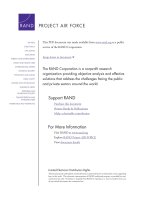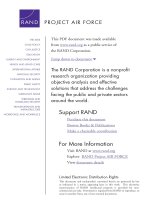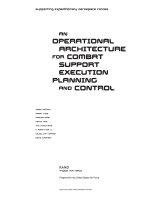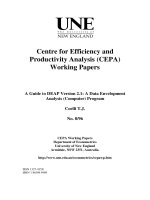surgical planning and biomechanical analysis
Bạn đang xem bản rút gọn của tài liệu. Xem và tải ngay bản đầy đủ của tài liệu tại đây (2.04 MB, 20 trang )
1
Surgical Planning and
Biomechanical Analysis
Balázs Erdőhelyi
1
Department of Image Processing and Computer Graphics
1
,
Department of Trauma Surgery
2
University of Szeged, Hungary
Endre Varga
2
, Attila Kuba
1
2
Overview
Segmen-
tation
Surface
Extraction
Mechanical
Model
Generation
Result
Evaluation
Analysis
Navigation
Surgical Planning
CT
FEA
JMed
Operating Theatre
3
Segmen-
tation
Surface
Extraction
Mechanical
Model
Generation
Result
Evaluation
Analysis
Surgical Planning
CT
MedEdit
FEA
Overview - CT
4
System Overview - Segmentation
Segmen-
tation
Surface
Extraction
Mechanical
Model
Generation
Result
Evaluation
Analysis
Surgical Planning
CT
MedEdit
FEA
5
Marching Cubes
~800k triangles
Simplification
~100k triangles
Overview – Surface Extraction
Segmen-
tation
Surface
Extraction
Mechanical
Model
Generation
Result
Evaluation
Analysis
Surgical Planning
CT
MedEdit
FEA
6
Overview – Surgical Planning
Segmen-
tation
Surface
Extraction
Mechanical
Model
Generation
Result
Evaluation
Analysis
Surgical Planning
CT
MedEdit
FEA
7
Segmen-
tation
Surface
Extraction
Mechanical
Model
Generation
Result
Evaluation
Analysis
Surgical Planning
CT
MedEdit
FEA
Overview – Mechanical Model
8
Segmen-
tation
Surface
Extraction
Mechanical
Model
Generation
Result
Evaluation
Analysis
Surgical Planning
CT
MedEdit
FEA
Overview – Result
9
CT
• DICOM (Digital Imaging
and Communications in
Medicine) format
• Image size: 512 x 512 px
• Slice thickness: 0.8–15 mm
• Number of slices: 80 - 350
Segmen-
tation
Surface
Extraction
Mechanical
Model
Generation
Result
Evaluation
Analysis
Surgical Planning
CT
MedEdit
FEA
10
Segmentation
• Convert 3D grayscale to
3D binary volume
• Algorithms
– Threshold
– Region Growing
– Fuzzy Segmentation
Segmen-
tation
Surface
Extraction
Mechanical
Model
Generation
Result
Evaluation
Analysis
Surgical Planning
CT
MedEdit
FEA
11
Thresholding
Original image
Threshold value
too high
Threshold value
too low
12
Region Growing
Original slice
Segmented
13
Region Growing
• Joined regions
• Undetected regions
14
Fuzzy Connectivity
• The weakest link in the strongest path
15
Segmentation - Post Processing
• Remove possible noise
• Fill holes
• Morphological operations
– Dilate
– Errode
– Opening
– Closing
16
Surface Generation
1. Use the Segmented volume
and create a triangle mesh
of the surface
– 2D
–3D
2. Simplify geometry
Segmen-
tation
Surface
Extraction
Mechanical
Model
Generation
Result
Evaluation
Analysis
Surgical Planning
CT
MedEdit
FEA
17
Contour following
Segmented image Contour points
18
Contour Simplification
• Collinear points are deleted
• Only the first and the last is kept
• Maximum distance as parameter of the
simplification
19
Contour Simplification
All contour points before
simplification
After simplification
20
2D contour reconstruction
• Bernhard Geiger (INRIA) : NUAGES
• Input: a set of simple closed polygons on
parallel planes
• Output: 3D surface
21
3D surface
Problems:
2D contours
pelvic bone is not „tubular”
Horizontal resolution is low
22
Surface Generation
1. Use the Segmented volume
and create a triangle mesh
of the surface
–2D
– 3D
2. Simplify geometry
Segmen-
tation
Surface
Extraction
Mechanical
Model
Generation
Result
Evaluation
Analysis
Surgical Planning
CT
MedEdit
FEA
23
Marching Squares I.
• Marching Squares (2D)
– 16 configurations
24
Marching Cubes
• Fully 3D
– 256 situations
– generalized in 15 families by rotations and
symetries
25
Marching Cubes II.
26
Marching Cubes
Surface generated with the marching cubes algorithm.
Number of triangles ~800.000
27
Surface Generation
1. Use the Segmented volume
and create a triangle mesh
of the surface
2. Simplify geometry
• Reduce rendering time
• Reduce analysis resources
Segmen-
tation
Surface
Extraction
Mechanical
Model
Generation
Result
Evaluation
Analysis
Surgical Planning
CT
MedEdit
FEA
28
Surface Simplification Methods
• Vertex Decimation
• Edge Collapse
• Vertex Clustering
• Face Merging
29
Vertex Decimation
• Schroeder et al, 92
• Based on controlled removal of
vertices
• Loop
– choose a removable vertex v
– delete v and its incident faces
– re-triangulate the hole
• Until
– no more removable vertex exists or
reduction rate fulfilled
30
Vertex Decimation
• Vertex is removable iff
– Distance to average plane is lower than e
max
– Distance to boundary is
lower than e
max
• Properties
– Efficient
– Simple implementation & use
– Works on large meshes
– Implemented in VTK
31
Edge Collapse
• Examine all vertex pairs
• Build queue of edges or V
1
, V
2
pairs where
• Loop
– Take edge e from the queue with the least error
– Delete e and its triangles
– Update queue
• Until
– Queue is empty or target reduction reached
tVV <−
21
r
r
Edge Collapse
• Error of a vertex is the sum of squared
distances to its planes
• Position of the new vertex is where the
vertex error is minimal
32
v1
v2
v
Vertex Clustering
• Object's bounding box is subdivided into a grid
• All vertices inside a cell are clustered to one
representative vertex
• Layout of the grid controls the simplified model
• Properties
–Very fast
– Poor quality
– No direct controll of
reduction rate
33 34
Co-planar face merging
• Kalvin, Taylor ’96
– Partitions the surface into connected
disjoint co-planar regions
– Regions are replaced by a polygon
– Polygon boundary is simplified
– Boundary retriangulated
35
Overview – Surgical Planning
• Repositioning
• Implants
Segmen-
tation
Surface
Extraction
Mechanical
Model
Generation
Result
Evaluation
Analysis
Surgical Planning
CT
MedEdit
FEA
36
Repositioning
As found on CT
After repositioning
37
Repositioning with the Mouse
38
Repositioning - Heptic device
/>39
Surgical Planning
• Treat bone surfaces as
objects in 3D space
• Transformations
– Translation
– Rotation
•Implants
–Screw
– Fixation Plate
BranchGroup
T
1
Shape
T
2
T
n
…
Shape Shape
40
Collision Detection
41
Surgical Planning
• 3D object positioning requires learning
• The model is 3D but the screen and the
mouse is 2D
• Collision detection can help
• Automatic tool is needed
Repositioning using Registration
• Semi-automatic: user selects surface pairs
• Do registration on every pair one-by one
• Cost function: sum of distances to the nearest
neighbours
• Search in 6 dim. space for the minimum of cost
function
• EA optimization
Example Example
Properties
• With constraints:
good matching of
points
• Fast: 5-8 seconds
• BUT: possible errors
– Segmentation
– Simplification
– User input
• Errors accumulate in
complex cases
Complex Fracture
Male, 40Y, 7 fragments
Pairwise Surface Registration
Global optimization
is needed!
Global Optimization
• All surface pairs are considered simultaneously
• Search space is (n-1)*6 dim.
• Stronger
constraints
• Improves
overall result
Global Positioning
Original fracture
Female, 52Y, 6 fragments
Healthy bone mirrored and
translated
Global Positioning
• Model contains 12k points
• Points used for registration 2k-6k
•Slow
54
Overview – Surgical Planning
• Repositioning
• Implants
– Screws
– Plates
Segmen-
tation
Surface
Extraction
Mechanical
Model
Generation
Result
Evaluation
Analysis
Surgical Planning
CT
MedEdit
FEA
55
Surgical Planning – Fixation Screw
• Screw parameters
– Length
– Insertion depth
– Shank diameter
– Tip length
– Head length/diameter
– Thread length
– Major / minor diameters
–Pitch
n
z
n x z
56
Surgical Planning – Fixation Plate
• Fixation plate
–Width
–Height
– Length
– Follow surface
57
Surgical Planning
58
Surgical Plan – Example II.
59
Surgical Plan – Example II.
60
Finite Element Analysis
•History
• Basic concept
• Material properties
• Mesh, element library
• How an enginier works
Segmen-
tation
Surface
Extraction
Mechanical
Model
Generation
Result
Evaluation
Analysis
Surgical Planning
CT
MedEdit
FEA
• Stress is a measure of the internal distribution of force
per unit area within a body that balances and reacts to
the loads applied to it.
F: force,
A: crossectional area
σ = F / A
• Unit: N / m
2
= Pa
61
Stress
L
F
A
F
62
Strain
ε = ΔL / L
L: original length
ΔL : change in length
Unit: no unit
L
F
A
F
ΔL
Strain
Strain is the geometrical expression of
deformation caused by the action of stress
63
Deformation
• Elastic region: the
deformation is
proportional to the
force
• Plastic region: the
material undergoes a
non-reversible
change
F
ΔL
Elastic
region
Plastic region
FF
non-reversible change
Yield point
64
Hooke's law
• Hooke’s law (1676): F, is proportional to u by a
constant factor, k
F = ku
Where, k is the spring constant, u stretching distance
• Elastic materials: E is the elastic modulus.
σ = Eε
F
u
65
Hooke's law
• Generalised to 3D by Cauchy
σ
xx
σ
yy
σ
zz
σ
yz
σ
zx
σ
xy
C
11
C
12
C
13
C
14
C
15
C
16
C
21
C
22
C
23
C
24
C
25
C
26
C
31
C
32
C
33
C
34
C
35
C
36
C
41
C
42
C
43
C
44
C
45
C
46
C
51
C
52
C
53
C
54
C
55
C
56
C
61
C
62
C
63
C
64
C
65
C
66
ε
xx
ε
yy
ε
zz
ε
yz
ε
zx
ε
xy
=
StrainStiffness matrixStress
66
Hooke's law
• Izotropic material: the material properties are
independent of direction (2 elastic constants)
• Ortotropic material: 2-3 orthogonal planes of
symmetry, where material properties are
independent of direction within each plane
• Anisotropyc (21 elastic constants)
67
Young's modulus
• Modulus of elasticity
• The slope of the stress-
strain curve
E = σ / ε
• SI unit: Pa
σ
ε
Elastic
region
Plastic region
Material E (GPa)
Diamond 1200
Steel 210
Iron 196
Aluminium 69
Bone 1.1
Cancelous
bone
0.01
Rubber 0.01
68
Poisson's ratio
•n = -ε
trans
/ ε
longitud
• -1 <= n < 0.5
Undeformed state
Deformed
state
• Defined as the ratio of the contraction strain
normal to the applied load divided by the
extension strain in the direction of the
applied load
Rubber 0.495
Steel 0.28
Bone 0.3
Cork 0.0
69
Negative Poisson's Ratio Materials
70
Finite Element Method
• If we can not solve the original problem,
let’s brake it into smaller, but well known
pieces and solve it that way!
K = 2rπ K
n
= nK
ij
K
ij
=K
45
=2r sin(π/n)
π
n
= K
n
/2r = n
71
FEA theory
Continuous problem Discrete problem
approximation
Ideal solution
Mathematics
Discrete solution
Computer
72
Finite Element Mesh
• The model is a mesh of springs
– Nodes define the geometry
– Elements define which
nodes are connected
Node
2-node
element
73
Element library I.
• Primitive elements
Rod
element
Pipe
element
Arbitrary
profil
Real
Discrete
74
Element library II.
• Shell elements: 2D, but with thickness
Triangle
Quadrangle
Real
Discrete
75
Element library III.
• 3D elements
Hexahedron
Tetrahedron
Real
Discrete
76
How an engineer works
Export design to a FEA system
77
How an engineer works
Assign material property: Alloy Steel
78
How an engineer works
Define fixed points
79
How an engineer works
Fixed points are marked green
80
How an engineer works
Load type, direction, and loaded area is defined
81
How an engineer works
Loaded area is marked with red arrows
82
How an engineer works
Generation of the finite element mesh
83
How an engineer works
The finite element mesh
84
How an engineer works
85
Irregular objects
• There is no CAD model of the patients
broken bone
• No automatic
mesh generation
• Fixed points and
loaded areas
CAD-pelvis
86
Mechanical Model Generation
• UI for Load and boundary
conditions
• Direct mesh generation
Segmen-
tation
Surface
Extraction
Mechanical
Model
Generation
Result
Evaluation
Analysis
Surgical Planning
CT
MedEdit
FEA
87
Mechanical Model
• Geometrical model
– Nodes
– Finite elements (shell, tetra, hexa)
– Material properties (Young’s modulus,
Poisson’ ratio)
– Load
– Boundary conditions
– Connections between objects
88
Load and boundary conditions
89
Load
90
Mechanical Model Generation
• UI for Load and BC
• Mesh generation
– Shell elements
– Solid (tetra-, hexahedron)
elements
• Quadtree / Octree
• Advancing Front
• Delaunay
Segmen-
tation
Surface
Extraction
Mechanical
Model
Generation
Result
Evaluation
Analysis
Surgical Planning
CT
MedEdit
FEA
91
Mechanical Model
Shell Elements
• Based on the geometry Æ 3-node shell el.
• Relation between objects Æ 2-node el.
Cortical bone
is 100x stiffer
cancelous
bone
3-node shell
elements
2 node finite
elements
92
Mechanical Model Generation
• UI for Load and BC
• Mesh generation
– Shell elements
– Solid (tetra-, hexahedron)
elements
• Quadtree / Octree
• Advancing Front
• Delaunay
Segmen-
tation
Surface
Extraction
Mechanical
Model
Generation
Result
Evaluation
Analysis
Surgical Planning
CT
MedEdit
FEA
Octree/Quadtree
• Start with bounding box
• Recursively build quadtree
Octree/Quadtree
• Triangulate Intersection, Side, and Corner
Points
Corner Point
Intersection Point
Side Point
95
Mechanical Model Generation
• UI for Load and BC
• Mesh generation
– Shell elements
– Solid (tetra-, hexahedron)
elements
• Quadtree / Octree
• Advancing Front
• Delaunay
Segmen-
tation
Surface
Extraction
Mechanical
Model
Generation
Result
Evaluation
Analysis
Surgical Planning
CT
MedEdit
FEA
Advancing Front
A
B
C
• Bundary is the initial front
• Process front segments
• Calculate ideal position for triangle
Advancing Front
A
B
C
r
D
• Check radius around optimal node for
existing front nodes
Advancing Front
D
• Delete orig. front elements and insert new ones
• Continue while front exists
Advancing Front
• Delete orig. front elements and insert new ones
• Continue while front exists
Advancing Front
• Delete orig. front elements and insert new ones
• Continue while front exists
Advancing Front
• Delete orig. front elements and insert new ones
• Continue while front exists
Advancing Front
A
B
C
r
• In case of multiple possibilities, chose
best quality
103
Mechanical Model Generation
• UI for Load and BC
• Mesh generation
– Shell elements
– Solid (tetra-, hexahedron)
elements
• Quadtree / Octree
• Advancing Front
• Delaunay
Segmen-
tation
Surface
Extraction
Mechanical
Model
Generation
Result
Evaluation
Analysis
Surgical Planning
CT
MedEdit
FEA
Delaunay Triangle
circumcircle
• Delaunay
Triangularization (DT): All
triangles satisfy the empty
circle property
• Empty circle property: No
other vertex is contained
within the circumcircle of
any triangle
X
Bowyer-Watson algoritmusa
Iteratively insert new points:
1. Find all triangles whose
circumcircle contains the
new node.
2. Remove edges interior to
these triangles
3. Connect nodes of this empty
space to new node.
X
Bowyer-Watson algoritmusa
Iteratively insert new points:
1. Find all triangles whose
circumcircle contains the
new node.
2. Remove edges interior to
these triangles
3. Connect nodes of this empty
space to new node.
107
Mechanical Model Generation
Segmen-
tation
Surface
Extraction
Mechanical
Model
Generation
Result
Evaluation
Analysis
Surgical Planning
CT
MedEdit
FEA
600N
Lateral Compression
108
Vertical Shear
109 110
Example I. - Hip
111
Example I.
112
Example I.
Example II. - Pelvis
• Female, 50Y
• Monday:
– Fall from a ladder
–CT
• Tuesday:
– Preparations
– Surgical planning
• Wednesday
– Operation
113
Example II. - Pelvis
114
Example II. - Pelvis
115 116
Example III. - Pelvis
Example IV. - Jaw
Preoperative Plan Biomechanical simulation
117 118
Conclusion
Segmen-
tation
Surface
Extraction
Mechanical
Model
Generation
Result
Evaluation
Analysis
Surgical Planning
CT
• Results match to the clinical
expectations
• Quantitative comparative
measurements still pending
• Possible Applications
– Clinical practice
–Education
– Navigation
– Research









